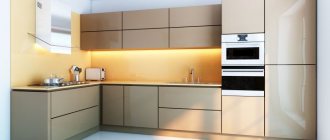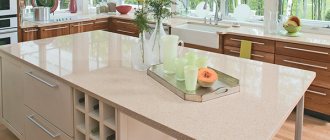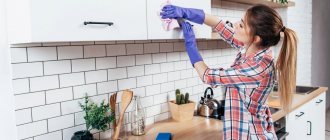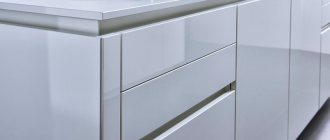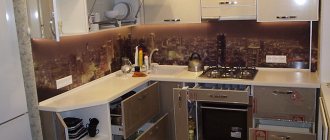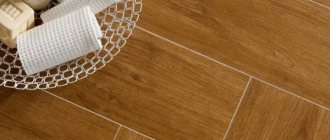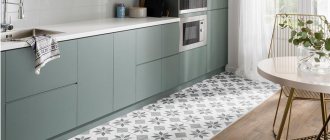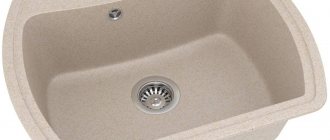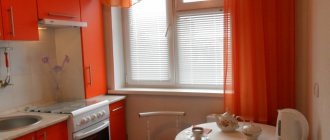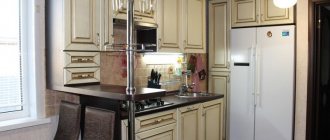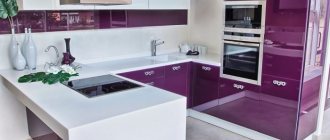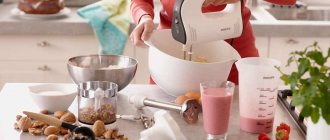How to choose the best wall panels for the kitchen
Wall panels are used near the worktop. It is this coating that helps protect surfaces from grease splashes and water droplets and keeps the kitchen aesthetically pleasing and clean. The service life of the panels, their aesthetic appeal and care details will largely depend on the material of manufacture.
Some of them are perfect for decorating very small kitchen spaces, while others are suitable for spacious and luxurious interiors. The article will tell you which wall panels for the kitchen are better and how to choose the best option.
Which panels are best for the kitchen: tips for choosing
The fashion for decorating walls or backsplashes with ceramic tiles is slowly but surely becoming a thing of the past. Increasingly, we choose other materials - from economical MDF to glass panels that are unimaginable in their design.
What is the advantage of wall panels? Firstly, the ease of installation. If the tiles require smooth walls and several days to lay, then the panels can also be installed on rough walls. Secondly, it's a matter of cost. Ceramic tiles are not a cheap pleasure, but laminated or plastic products will save your budget. Let's look at the entire range of materials for decorating walls and decide which ones are best suited for the kitchen.
What to consider when choosing?
When purchasing material for cladding ceilings or walls, pay attention to the following aspects:
- the correct geometry of each canvas - without waves or distortions;
- uniformity and quality of coloring, color saturation of all lamellas;
- absence of chips, cracks, scratches and other damage;
- matching pattern.
To purchase high-quality finishing materials, go to a large hardware store. This will help you avoid buying defective PVC lamellas and problems with them - from unsatisfactory results in repairs to the release of harmful substances into the air.
The photo shows sheet plastic for ceramic tiles
Top three – from MDF to plastic
If you are faced with the choice of covering for kitchen walls for the first time, the first question that will arise is what types of wall panels are there? All products can be roughly divided into several types: glass, plastic, chipboard and MDF, as well as natural materials. Each type has its own advantages and disadvantages. Let's look at the top three, which are most often chosen for decorating and protecting kitchen walls.
MDF panels
Let’s say right away that you should choose laminated MDF as wall panels. This can be a product where only the front side is covered or a model with two laminated surfaces. The last option is better, more reliable, but more expensive. Laminated MDF, unlike regular sheet metal, repels dirt and is easier to clean.
This material has several other advantages:
Such panels can be installed quite easily in the kitchen yourself. Below you can see photos of laminated MDF wall panels.
As for the disadvantages , it is worth saying that the material can easily ignite and does not tolerate constant moisture. Although the sheet is coated on both sides with a protective coating, it can become deformed from exposure to moisture.
If you need to wash off grease from laminated MDF, it is better to use soft sponges and brushes.
Plastic products
The most popular option for covering kitchen walls. Its main advantages are versatility and affordable cost. If ten years ago plastic was used most often in government agencies, today this material has become more versatile due to the appearance of more colors and textures. What's good about plastic:
Another advantage worth noting is the ease of installation. When tiles require laying skills and wall preparation, plastic can be installed in a few hours. Modern kitchen panels made of plastic can be not only the standard snow-white color, but also have a glossy shine, textured patterns and eye-catching colors. In the photo below you can look at the interior of the kitchen, where the walls are lined with plastic panels.
As for the disadvantages , plastic is “afraid” of high temperatures, so such products should not be placed near a gas stove. Plastic can also be scratched or damaged, especially if washed and cleaned with hard brushes.
Laminated chipboard
The most budget option for decorating kitchen walls. Compared to ordinary chipboard, laminated panels can be thoroughly washed and cleaned - they do not deform and retain their shine. All this is due to the fact that such panels have a laminated front side, which acts as both a protective shield and a decorative finish. The main advantage of laminated chipboard is its low price. We can say that this option for the kitchen combines accessibility and practicality. In the next photo you can see what laminated chipboard looks like in the kitchen interior.
This material also has a couple of disadvantages.
The first is the fear of temperature changes. Of course, if you are choosing panels for a kitchen in a multi-storey building, you should not be afraid of this drawback, but for a kitchen in a private house or a kitchen-veranda it is better to choose another option.
The second is the short service life. While tiles can serve you for decades, laminated chipboard panels can become deformed when exposed to moisture or steam. If you frequently wash and clean kitchen panels with chemicals, they will lose their visual appeal.
Interesting design ideas
When covering walls with panels, the design of the future coating also plays an important role. It should look beautiful, original, and complement the interior of the entire room. It is advisable to hide all communications and pipes. They can be neatly put away in the sheathing, but they will not disturb the overall appearance of the kitchen. If you plan to hide the wiring, then you should not wall it up tightly. You definitely need to provide access to it; to do this, you can make a small door in the plastic covering to access the wiring.
In addition, when decorating a kitchen space, it is worth remembering a few important tips:
- If the room is small, then you should choose light colors for the wall surface. A light tone will make the room even wider;
- It is not advisable to choose bright colors or large patterns. This style is best used for an apron;
- colors can be combined, but the main thing is that they match. It is better to first look at the photo with the methods of such design;
- The shade of the plastic base can be changed using self-adhesive film. How to do this can be seen in various photos.
Finishing the kitchen with plastic panels is an unusual option to decorate this room in a stylish, original way.
The main thing is to choose the right material so that it is durable, fire-resistant, and wear-resistant. In addition, it must fit into the overall style of the room and be in harmony with all pieces of furniture. Therefore, before you start working on decorating walls with plastic, it is better to look at photos with finishing options.
“Expensive walls”: options for exquisite wall decoration
In addition to the popular panels made of MDF, chipboard and plastic, there are other types of materials that can be used in the kitchen. Of course, they will not be cheap, but they will be able to create the right atmosphere in the room or emphasize the features of the interior.
You should choose panels for the kitchen based on the most important parameters: they are easy to clean, they are not afraid of moisture and will be able to surprise you with their appearance for several years. The most budget options have these characteristics, but are afraid of high temperatures. More expensive products can also be installed in the apron area, but you will have to spend a considerable amount on finishing the walls.
Source
Design ideas
Cheap plastic is an excellent option for decorating walls in a country house. But there are also options in the middle and high price categories that look no worse than ceramic tiles or the same wallpaper, and will last much longer.
We have collected for you some interesting ideas for decorating walls in the kitchen with budget and expensive plastic panels, which you can take note of.
- Matte and glossy.
- With an image.
- With imitation of natural materials.
- Plain and monochrome.
- With horizontal and vertical mounting.
Sources
- https://spark-welding.ru/klej-i-germetiki/kuhnya-otdelannaya-panelyami.html
- https://idealkuhnya.ru/steni/panely/pvh.html
- https://onkuhnya.ru/steni/plastikovye-paneli-dlya-kuhni/
- https://design-homes.ru/komnaty/kukhnya-i-stolovaya/otdelka-kukhni-pvkh-panelyami
- https://www.vusnet.ru/obedennaya/4-otdelka-kuhni-plastikovymi-panelyami.html
- https://www.InMyRoom.ru/posts/16260-otdelka-kuhni-plastikovymi-panelyami-foto-variantov-dizajna
- https://diz-kitchen.ru/%F0%9F%A4%A6%E2%80%8D%E2%99%82remont/paneli-pvx-dlya-kuxni.html
- https://www.ivd.ru/dizajn-i-dekor/kuhna/paneli-pvh-dlya-kuhni-plyusy-i-minusy-otdelki-plastikom-74441
- https://dizainkyhni.com/remont-kuhni/stenovye-paneli-dlya-kuxni-foto-primery-i-interesnye-idei-dizajna.html
- https://akuhnja.com/steny/paneli/otdelka-kuhni-panelyami-pvh.html
[collapse]
Which wall panels to choose for wall decoration in the kitchen?
In recent years, many new finishing materials have appeared on the market, which today can surprise few people.
They were able to amaze consumers with their bright decorative properties, but this led to the fact that people began to pay less attention to maintaining the environment and hygiene in the kitchen. When it comes to decorating an apartment with your own hands, for many craftsmen such a criterion as ease of execution becomes very important.
Naturally, old technologies are inferior to new materials in the sense that they significantly increase the cost of finishing work. Unfortunately, many people today believe that paint and ceramic tiles are the only viable options for finishing surfaces in the home. However, manufacturers have an answer to changing needs. Today they offer kitchen wall panels for kitchen decoration.
They prove their superiority with impressive performance characteristics, in which many traditional materials cannot compete with them on equal terms. In addition, they offer wider possibilities for decorating the interior of the kitchen space. With the help of kitchen wall panels it is very easy to give the room an individual appearance that will bring aesthetic pleasure to the owner and all family members during every minute spent in the kitchen.
How to panel
If you don’t know how to properly cover a kitchen with plastic panels, contact a specialist. Although in fact this process is extremely simple and often the owners of houses and apartments do such work with their own hands.
When installing PVC panels, special fittings are used - starting, corner and joining profiles, which give the finish a finished and neat look
Installation of panels consists of several stages. At the first stage, the walls are prepared. All protruding elements are removed from the surface and their surface is leveled. It is necessary to think in advance and determine the mounting locations for switches and sockets. Next comes the process of installing the frame, which is the key to the strength of the wall cladding. The frame can be made of wooden and metal slats. The latter option is considered the most durable and reliable. Wood slats and metal slats are attached according to the same principle.
Stage 1 – surface preparation
Stage 2 – installation of the sheathing
Stage 3 – installation of panels
The frame can be installed vertically or horizontally. The method is determined in accordance with the chosen method of installing the panels - vertical or horizontal.
Wooden slats or metal profiles are attached to the walls from floor to ceiling in such a way that there is a strictly vertical distance from the bottom to the top plank. You can use a building level or plumb line for measurement. The ideal option is a construction laser.
In order for the finishing with plastic panels to come out smooth and beautiful, the lathing must be aligned in the same plane
When the frame is ready, the final stage of work begins - attaching the panels. To do this, you will also need to use profiles on which the sheets will be attached. After installing the panels, you can begin finishing with baseboards.
Installation of panels begins with the installation of starting profiles
Using panels to decorate a kitchen can be called a simple, affordable and original solution. The material fits quite easily into any interior design and it is not surprising that today plastic is becoming one of the most popular building materials.
Types of wall panels
Before you begin installing kitchen wall panels, you need to decide which ones the owner will use to decorate the kitchen. It should be borne in mind that this finishing material is presented in various versions , which differ from each other in size and shape.
Therefore, when choosing, you need to pay attention to the configuration and other features of the room. The diversity of this finishing material can be represented in three types:
Leafy
Rack and pinion
In fact, they are long narrow strips. In appearance they are very reminiscent of lining. They can have a length from 2.4 to 3 meters or more . They can vary greatly in width, but most are 300mm. Panels of this type have a slight thickness, ranging from 1 to 6 mm. Most often in construction, the method of vertical installation of these slats is used.
Tiled
Unlike the above types, these wall panels have a square shape with a side length of 980 mm. This makes them the best option for installing on the walls of most kitchens. Another advantage that follows from their shape is that it ensures uniform distribution of the finishing material over the wall surface. Due to this, even a novice master can calculate the amount of material and achieve maximum savings on its purchase.
Ceiling
Ceiling finishing materials are quite fragile and light in weight. If the material is not handled carefully, there is a high risk of dents appearing, which will ruin the appearance.
Ceiling panels are manufactured in a wide range of widths, colors and texture imitation - including wood and marble. The surface can be either matte or glossy. Gloss is acquired through a special varnish coating. There are options on sale with a pattern obtained by applying printing or thermal film. The printing is applied to the panel itself and, unlike thermal film, requires specialized equipment, so its cost will be slightly higher.
The panel ceiling, among others, has special advantages:
- allows you to hide uneven ceilings, wiring and small diameter pipes;
- if the neighbors are flooded, the panels will simply dry without deformation or damage.
- They are not afraid of temperature changes, have no odor and are absolutely safe.
The only caveat: the profiles used for installation will slightly reduce the usual ceiling height.
Kitchen wall panel materials
Today on sale you can find various options for kitchen wall panels, which can be made from materials such as:
To understand how they differ from each other, let’s take a closer look at their positive and negative properties.
Plastic
This material is most often used for the manufacture of wall panels. Its demand is explained by the presence of the following undeniable advantages:
But at the same time, you need to take into account that plastic has a number of disadvantages . The main one is its origin. This material cannot be called environmentally friendly, so not all owners agree to purchase products made from it. It is also very susceptible to mechanical stress. It does not always withstand impacts, which often result in the appearance of cracks and sometimes even complete failure of the panel.
As a result, the owner has no choice but to replace the damaged fragments. This drawback requires the owner to install plastic panels on a fairly thick sheathing so that mechanical loads do not have such a strong destructive effect on the material, and this will allow the panels to last much longer in the kitchen.
Glass
Recently, the owners' tastes have changed, and some already want to see something original in the house. Therefore, they choose glass panels, and this choice cannot be called wrong. After all, this material not only looks beautiful, but is also capable of serving no less than plastic, provided that the operating rules are followed. Speaking about the advantages of glass panels, it is worth highlighting the following:
Among the disadvantages that glass wall panels have, we can note the specific requirements for operation . Once again, we repeat that you need to handle the panels very carefully and avoid excessive shock loads. These panels also do not withstand sudden temperature changes, so it is advisable to install the hob away from the wall.
Fibreboard, chipboard, MDF
In very rare cases, chipboard is used to decorate the kitchen. This is due to the disadvantages of this material - high sensitivity to moisture and low strength.
MDF panels differ from chipboard in that they resist moisture much better. In addition, they do not allow fungus to multiply. But they cannot withstand exposure to high temperatures for a long time, so they quickly lose their attractive appearance and at the same time their performance properties deteriorate. At temperatures above 100 ° C, MDF panels begin to warp and damage occurs on their surface.
Tree
Wood is not often used to decorate the kitchen. It's all about its high cost. But even if the owner decides to purchase wall panels made from this environmentally friendly material, he must not forget that wood is very sensitive to high humidity. This imposes special requirements for their installation: the material requires especially careful preparation, which involves the use of special technologies for protection from moisture and antiseptic impregnations.
To ensure that wooden panels retain their decorative properties longer and better resist moisture, they are treated with special wax compounds that protect the material from delamination, cracks and dirt deposits.
Panels of this type can be made of wood of different species, which differ in their cost. The most common of them are cedar, oak, etc.
Kitchen apron made of plastic
These panels are the most popular on the list. First of all, they attract buyers with an affordable price. Despite their low cost, plastic aprons have many advantages:
- They are very easy to care for;
- Plastic can withstand chemical cleaning agents;
- Excellent tolerance to high humidity conditions;
- Easy to install. Anyone can handle the installation;
- Huge selection of designs. Plastic is a universal material that can be painted in any color, have a pattern applied to it, or even imitate wood, marble or bamboo.
The following points can be highlighted from the disadvantages of plastic panels:
- Plastic cannot withstand high temperatures and may begin to melt. Take this into account when finishing the apron near the stove with this material;
- The surface is unstable to mechanical stress. The plastic apron must be handled carefully so as not to accidentally leave scratches on it - this is very easy to do.
Advantages and disadvantages
The undoubted advantage of wall panels is their versatility. With their help, you can decorate the apron and walls in the entire kitchen or just in the work area.
Coatings are made from a variety of materials - synthetic and natural, so they can be heat- and water-resistant, imitate tiles or wood.
This finish looks stylish and modern, and is also practical, wear-resistant and easy to clean.
Most often, panels are chosen to decorate those areas in the kitchen that are subject to maximum contamination.
Panel surfaces are easy to clean with an ordinary cloth, and therefore are convenient as a kitchen apron. Therefore, they are often used next to the stove and sink, even if they are located separately from the main work area.
Advantages of wall panels for the kitchen:
The disadvantages, as well as the advantages, depend on the material. The disadvantage of finishing made of glass, natural wood, or metal is the rather high price.
The downside of plastic panels may be their not very high strength and resistance to physical damage.
MDF surfaces have another noticeable disadvantage - insufficient water resistance, which is why they are rarely used for apron design. In addition, such finishing can release harmful toxins, but this only applies to low-quality materials and improper conditions of their use.
Brick kitchen apron
Imitation brick finishes are often found in kitchen designs. Although initially it was typical only for lofts, now brick is used in many modern interiors. Most often, such aprons are made in white - they look discreet, but at the same time not as simple as ordinary ones.
Choosing material
The practicality and functionality of the panels also depends on what they are made of. Each material has its own properties and characteristics, on which the quality, and therefore the price, depends.
Plastic
The most affordable option that is suitable for any kitchen space, regardless of size and interior design.
Plastic panels can be bought in any city, including Moscow and St. Petersburg, almost everywhere: in online stores and in construction supermarkets. Plastic finishing materials are even presented in the stores of the famous company Leroy Merlin.
The advantages of plastic are not only its cost-effectiveness, but also its ease of installation and ease of operation. Plastic is moisture resistant, but some types of PVC coatings may not be fireproof enough.
Glass
The most expensive and most beautiful material for wall panels is glass. Tempered high-strength glass not only looks good, but is also resistant to active chemical and physical influences, high temperatures and moisture.
Glass coverings with photo printing allow you to create an unusual and unique interior in a modern, hi-tech or minimalist style.
Glass panels have practically no disadvantages, except for their high price. The only drawback is that splashes of water may remain on them, which can be easily removed with a rag.
Chipboard trim is an inexpensive option, but is quite modern and quite beautiful. Externally, chipboard coatings can imitate a variety of textures - from stone to wood. Their disadvantage is their relatively low wear resistance.
Another interesting option for kitchen finishing is made from MDF. Thanks to the cozy and natural texture of wood, MDF panels can be used to decorate not only the work area, but also the dining area.
When installed and in everyday use, this material shows its best performance: it is easy to work with and easy to care for. This finish is considered environmentally friendly and heat-resistant, but it also has disadvantages, for example, a low level of moisture resistance.
"Under the tiles"
Ceramic tiles today are one of the most expensive finishing materials, but there is a worthy alternative in the form of special tile panels, which are most often made from PVC. Some types of such coatings exactly imitate tiles, so they do not look “cheap” and simple.
Metal
An original solution for a loft-style kitchen is to use metal panels for the apron. Metal (copper, aluminum, steel) is a very strong and incredibly durable material. It can only be at risk of rust if not properly cared for. Metal is also one of the most expensive coating options.
Tree
Wooden panels are expensive, but they look very expensive and noble. With their help you can completely decorate your entire kitchen. They are suitable for classic, country, Provence or ethnic style. In the photo on the Internet you can see how luxurious this finish looks. It has virtually no downsides, except for the high price.
Source
Wood-effect kitchen apron
If you want a wooden panel, but are not willing to spend a lot on it, the best solution is an MDF panel. It exactly imitates wood texture and is inexpensive. Good MDF panels are practically indistinguishable from their natural wood counterparts.
What are kitchen wall panels?
A kitchen wall panel is the vertical space from the countertop to the beginning of the kitchen's top drawers. The standard height of the apron does not exceed 60 cm.
The kitchen apron is the second zone of the kitchen, which is exposed to water, temperature changes and food contamination. Its functional duty is to protect walls from oil drops, but it also has a decorative component.
Features of installing panels
A standard panel has a length of 3 m and a width of 60 cm. To install the apron, it is necessary to cut the sheet according to the calculations made, taking into account utilities. Frameless installation is most often practiced.
Before installing the panels, you must definitely get rid of the old finish and level the surface of the walls, get rid of crumbling plaster using a hammer drill.
Special glue is applied to the walls using a notched trowel for better adhesion of the panel to the wall. The seams are sealed with adhesive. Finishing can continue up to the ceiling, in which case the product must be secured under the ceiling plinth.
Many models are available with locking fastenings, which provide a strong connection between the joints between the sheets.
Material
An important criterion for choosing a wall covering is the material from which it will be made. Kitchen aprons are often made of glass, plastic, MDF and artificial stone.
Plastic is the most common option for wall decoration. Its main advantages are low price and versatility. In addition, plastic products do not require special care. You can restore the panels to good condition using available chemical cleaning agents.
Plastic coverings have high resistance to moisture, as well as sound and heat insulation. To install them, you do not need to have special knowledge, and installation takes no more than two hours.
Plastic is a material that lends itself easily to design solutions. It can combine several colors, have a glossy shine or a textured pattern.
Disadvantages of plastic panels:
MDF, fiberboard, chipboard. To create kitchen aprons, manufacturers use fiberboard sheets. For decorative purposes, MDF and chipboard sheets are more suitable.
During manufacturing, each sheet of material is treated with a special agent to increase the strength of the product. The fiberboard is additionally covered with thin plastic, which protects the material from moisture.
Disadvantages of MDF, fiberboard and chipboard panels:
Laminated chipboard is a practical material with an affordable price. Laminated chipboard is used to create an imitation of brickwork, expensive wood or natural stone. The material is often installed in apartment buildings, since it is not suitable for a private house.
Disadvantages of laminated chipboard panels:
Tree. For a kitchen apron, natural or veneered wood is used. Natural and environmentally friendly material is well suited for any interior.
Solid wood is treated with wax, which protects the panel from moisture, insects and mechanical stress. In addition, it is coated with a layer of varnish so that the structure of the material does not deform.
The protective coating on wooden wall panels must be constantly renewed.
In the construction market, natural wood has a high price, but products made from pine, linden or alder are available to everyone.
Disadvantages of wooden panels:
Glass is a material that is often used when creating a kitchen apron. Its main advantage is its hygiene. There are no seams or joints on the glass work surface, which means it is easy to care for.
The glass panel helps to create unusual design solutions. For example, you can place your favorite posters or photo wallpapers behind the glass. A design is applied to the glass itself using various techniques - stained glass painting, acrylic paints, gluing a special film, etc.
Glass panels are made of tempered glass, and to increase strength the material is covered with a protective film. Upon impact, the glass will not shatter into fragments, but simply crack.
Disadvantages of glass panels:
Artificial stone is a material that is resistant to many chemicals, high temperature and moisture. The product has a high density, the top layer of which can be polished, making it as smooth and glossy as possible.
During cleaning, it is permissible to use disinfectants to avoid the appearance of mold and fungi.
It is difficult to damage artificial stone, but if this happens, scratches and small chips can be polished.
Disadvantages of artificial stone panels:
Glass kitchen apron
Glass panels look modern and original. Their main advantage is the absence of joints on the surface, which makes the apron hygienic. There are no seams - no dirt accumulates, which means caring for the panels will not cause problems. This apron opens up many possibilities for interior decoration. For example, behind the glass there may be your photographs, favorite recipes, photo wallpapers and much more - it all depends on the owner’s imagination. This unusual method will help you save money while getting a beautifully designed apron. The glass itself is often decorated. You can apply a stained glass pattern to it yourself, or order a ready-made product, paint it with acrylic paints, or purchase an apron with a decorative film attached.
Don't worry about the panel breaking. Such aprons are made of special tempered glass, which has increased strength and is resistant to heavy loads. For additional reliability, the products are covered with a protective film. If the load is exceeded, the glass breaks like a “web” - the fragments remain on the film, so it is completely safe.
Disadvantages of glass panels:
- When ordering, you need to accurately determine the size of the product. If the panel does not fit, it will not be possible to reduce it - the glass cannot be cut.
- If the glass is transparent, the surface must be thoroughly cleaned of dirt so that the apron looks presentable.
- Relatively high price.
Manufacturing form
Wall panels for the kitchen can be made in three forms:
Kitchen apron for porcelain stoneware
This type of wall panels looks good in most styles. Porcelain tiles are suitable for classics, Provence, and modern style. Paired with such an apron, gray household appliances look very appropriate.
Color and decor
A kitchen with wall panels always looks original and unusual. To achieve this effect, materials in different colors are used.
White
White color is one of the universal colors, so it will fit well into any interior and kitchen style. In addition, it is easy to combine with bright shades of furniture.
For a classic white kitchen backsplash, use ceramic tiles. A more interesting option is to imitate a brick wall, especially if the work area is equipped with additional lighting.
Black wall panels
A black panel in the kitchen always looks discreet and elegant. If you add light furniture to the kitchen space, it will create a contrast with the panel, which is why the dark color will not look gloomy or boring.
Perhaps you want a dark kitchen, but the size of the room does not allow it. In this case, let the base color be white, and the apron and work area remain black. With this solution you will preserve the feeling of space and satisfy your needs.
Gray
A gray kitchen apron looks ideal in contrasting designs, as it creates calmness and laconicism. If your countertop is green, yellow, red or blue, choose gray shades from light to dark for the panels.
Brick wall panels for kitchens
Finishing a kitchen with a brick wall panel remains one of the most popular. Brick is suitable for any design solution, as it is a component of many interiors.
Brick, including decorative ones, absorbs light. Its installation should be carried out in well-lit rooms.
With photo printing
The main advantages of this solution are a large selection of materials and the ability to add an individual design. All you have to do is choose the method of applying the image:
In the second case, the image will be brighter and the paint will not peel off.
Under the tree
For this technique, MDF material and the principle of photo printing are used. This allows you to create a variety of designs and imitate expensive tree species. This solution costs the buyer much less, and the panel itself is suitable for most classic styles.
Under porcelain stoneware
A porcelain stoneware wall panel looks good in a classic interior with a lot of furniture and household appliances. Using panels in a light shade and with a pattern, you can imitate the Provence style in the kitchen.
Dark panels are suitable for a modern style. They can be used wisely in small kitchens, as well as in studio apartments.
Marbled
Imitation white marble looks elegant and noble. Marble is the easiest to integrate into a classic style, and to make it reflect light beautifully, add additional lighting sources.
An imitation of black marble is created using artificial stone panels. They will harmoniously combine in a modern style interior.
Interesting uses
Wall and ceiling panels allow you to realize the most original design due to the frame design. This can be a ceiling divided into zones or solutions using combinations of color and texture. Those in the form of lining allow the installation of spotlights that can literally transform a boring room. LED lighting will look no less impressive.
Designer panels can become a real decoration of the kitchen, turning it into an example of modern style and practicality. Photos of such works really amaze the imagination. No less interesting will be materials imitating wood, bamboo or marble. If you choose a wall panel with a shelf, you can get a functional place for storing jars, dishes or spices.
